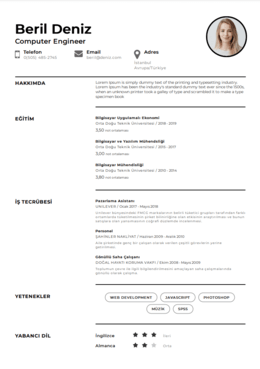Resume Help Pelin Özbilgin
How to Write a CV for a Job Application in 2022 (Guide)
Yeni CV örneklerini inceleYou've discovered the ideal employment opportunity. You send your resume and anxiously await a call-back, but it never comes. Any resemblance? For the majority of us, it does. How is that feasible, though?
Nobody has ever read your resume. It wasn't adequate.
Take heart—this terrible scenario won't ever happen again. You're about to learn how to create a CV that nobody will be able to put down.
If you read this guide, you'll learn:
Better than nine out of ten other CV samples.
even if you have no experience, how to write a curriculum vitae
Advice and examples on how to best present your accomplishments and talents on a CV.
How to create a CV and good CV ideas for landing any job you want.
A sample CV is provided below.
Be sure you understand when to utilize a CV.
Select the ideal CV format.
Add your contact details appropriately.
Create a CV personal profile first (CV summary or CV objective)
Describe your prior employment and major accomplishments.
Build the education portion of your CV properly.
Add qualifications that are pertinent to the job posting.
To impress the recruiter, add more parts to your resume.
Put all of this information on a good CV template.
Include a cover letter with your resume.
Here are some CV examples for different scenarios: 100+ Resume Examples for All Jobs
Make Sure that You Know When to Use a CV
To make CV writing simple, let's start with the fundamentals:
A CV is what?
Curriculum vitae is what CV stands for in its whole form (latin for: course of life). A CV is a document used for academic purposes in the US, Canada, and Australia. Your academic career is fully described in your US academic CV. The CV is the international equivalent of the résumé. When you apply for jobs, you use it.
Many people continue to ask: Why is this document called differently in different countries?
What distinguishes a resume from a cv?
Let's be clear about this once and for all:
Nowadays, there is seldom any formal distinction between a CV and a resume in the hiring market. It's the same thing that Americans and British refer to as a resume.
Similar to like they do with French fries and football, or Queen Elizabeth and Queen Bey.
Therefore, you should write a CV if you're applying to a company in Europe. However, you should create a resume if you're applying to a company with a US address.
A CV is not a cover letter, and likewise. A cover letter is like a full-fledged marketing campaign, but a curriculum vitae is like a complete list of requirements.
Here's a worrying idea:
You compete against 250 other applicants on average each time you apply for a job.
You did read that correctly.
Assume you are the recruiter and you have 250 job applications to review. Do you read them all carefully? Of course you don't, though.
Only six seconds are spent by recruiters scanning each CV. Therefore, the first impression is crucial. You'll persuade the recruiters to give your CV more attention if you provide a tidy, well-organized document.
On the other hand, a poorly structured CV will cause you to be overlooked during the initial inspection.
Here's a guide to proper CV formatting.
Make an outline for your CV first, using the following sections:
CV: Sections in the Correct Order
1)CV Header With Contact Information
2)Personal Profile:CV Objective or CV Summary
3)Work Experience
4)Education
5)Skills
6)Additional Section
Pro Tip: Put your schooling section above your work experience if you're fresh out of college and need to build a student CV with no experience or if you've graduated from a very prestigious university within the last five years.
Always bear in mind the gold CV formatting guidelines when filling out the sections:
Select readable, clean typefaces.
Use one of the traditional CV typefaces, such as Times New Roman or Bookman Old Style if you often choose serif fonts over sans-serif ones like Arial, Tahoma, or Helvetica.
Use single spacing and a font size of 11 to 12. Choose a font size of 14 to 16 points for your name and section titles.
Keep your resume's design consistent.
All four sides should have one-inch margins.
Make sure the headlines on your resume are all the same size, bold, and use little underlining and italics.
On your resume, use a single dates format, such as 11-2017 or November 2017.
Don’t cram your CV with gimmicky graphics
Less is more.
White space is your friend—recruiters need some breathing room!
Plus, most of the time, after you send out your CV, it’s going to be printed in black ink on white paper. Too many graphics might make it illegible.
Get photographs off of your CV
Unless your picture is specifically requested to be in the job posting.
If so, pick a photograph that looks professional but isn't as rigid as an ID shot.
Create a concise and pertinent resume.
Don't be one of the job seekers trapped in the 1990s who believes their resumes must contain every single nuance of their lives.
These days, hiring is a very busy business. Nobody has time to read ten or more bullet point descriptions of your previous jobs or care about the high school you attended. Later, we'll discuss that.
Pro Tip: To ensure that your CV arrangement is preserved when you've completed writing, save your document as a PDF. But be sure to read the job description carefully. A PDF CV won't be accepted by all employers. Send your CV in Word if that's the case.
So you know the fundamentals of CV writing and have the greatest CV template ready for you. It's time to start!
Add Your Contact Information the Right Way
You must provide the recruiters with contact information if you want them to contact you.
Enter your details under "Contact Information"
Entire name
Title of expertise
Inbox address
Call-in number
Profile on LinkedIn
Home address
The portion that contains contact information appears to be quite simple, but for one reason it might be challenging:
It will be used by recruiters to look you up online. You're out of the running as soon as your social media profiles lack professionalism or the information on your LinkedIn page doesn't match that on your resume.
Start with a CV Personal Profile (CV Summary or CV Objective)
Most applicants begin their work experience or educational background shortly after including their contact information on a CV.
You'll succeed more than that, though. The employer will genuinely remember you.
So how can a CV stand out?
All you need is a brief, succinct CV personal profile statement that explains to hiring managers why you are the ideal applicant for the position.
Either a CV objective or a CV summary will serve as your personal profile.
What's the distinction?
A CV objective outlines your strengths and how you might fit in. It's a wise decision if, for instance, you're drafting a student CV and have limited work experience that relates to the position you're applying for.
In contrast, a CV summary shows your professional development and accomplishments. If you're an experienced professional with a ton of experience in your sector, use it.
Check out a few examples now. Consider a nursing position that is advertised. Here are some examples of nursing CV summaries and aims.
A CV objective example
WRONG
A tough nursing position in a hospital where I can put my talents to the test is what I'm searching for as a newly certified nurse.
Not too bad, right? The issue is that this CV objective's main message practically amounts to "I want a job because I learned for the job."
View a different CV objective example.
RIGHT
Trustworthy licensed NMC Registered Nurse with experience working in high-stress situations and the ability to maintain composure. In order to assist St Francis Hospital with its forthcoming problems, I will use my rigorous record-keeping and analytical abilities.
See the distinction? The latter applicant was just concerned with what she could provide her potential employer. The name of the particular hospital to which she is applying was also mentioned.
And certainly, mentioning names in your CV objective is something you should do as well.
It's true that you won't be able to spam your CV to every employer who is actively hiring, but when was the last time you responded to a "Dear User" email?
We previously advised starting your CV with a CV summary rather than an objective if you had prior relevant work experience.
View these examples of CV summaries.
CV summary example
RIGHT
Pediatric nurse with over 15 years of experience in a community hospital's critical and newborn care units. Bilingual (English and Dutch). As the Chief Pediatric Nurse at the General Hospital, I'm want to use my managerial experience to aid in the implementation of new staff training initiatives.
The director of the general hospital just took up the phone to call this applicant.
What makes this CV summary so fantastic?
It is really specific, above all. It provides a thorough overview of the candidate's past and demonstrates how her experience will enable her to address specific issues the hospital is now experiencing.
Here is an additional CV summary illustration.
Wrong Pediatric Nurse has years of experience monitoring neonates' medical records and meds.
On the other hand, this one only states, "I am a nurse." It only outlines the standard duties that all nurses must perform.
Never use meaningless jargon in the summary of your CV.
List Your Relevant Work Experience & Key Achievements
Your work experience section is typically the most significant and attention-grabbing area of your entire CV.
Think twice before saying, "Easy, I only need to identify my past positions, the dates worked, and my responsibilities."
A basic CV must include each of the aforementioned items. Basic, however, won't land you that dream job.
However, hiring managers are aware of your actions. They are interested in your performance and what you can bring to a potential employer.
Here's how to demonstrate that in your work experience section:
Instead of just concentrating on your obligations, pay attention to your quantifiable, pertinent accomplishments.
Use action verbs rather than "responsible for producing, analyzing, and implementing," such as "created," "analyzed," and "implemented."
Read the job description attentively and see what responsibilities will be placed on you before you submit your resume. Even if those weren't your primary responsibilities, if you've done them in the past, list them on your resume.
Let's look at an actual CV example.
The following is an example of a job description for a junior product marketing professional.
Responsibilities:
Fulfilling media requests for product placement
Making and keeping media lists as necessary
The creation of product pitches
Looking into new media possibilities
Aid in producing press kits and media materials
Manage a modest project from beginning to end Assist in event planning
Answer questions from the media
Take a look at this CV entry example for work experience now.
Work experience section of a resume sample
Marketer of goods
Nike, 10/15/2015 – now
London
Compiled and updated media contact lists
Investigated possibilities using various internet media platforms
Produced press kits and two product pitches
Aided the event's planning
Reacted to media requests
Key accomplishment: Growing a new line of lifestyle items' Facebook fan base from 0 to 12,000 in 4 months [LINK to the Facebook fanpage] and gaining 35,000 Instagram followers [LINK to the Instagram account] in 3 months while leading a project team of five people.
Wow, this one needs to cooperate with us!
The recruiting manager will undoubtedly respond in such way to this entry.
What makes it so great?
It's firstly perfectly adapted to the job posting (have another look at the numbered phrases in bold). The candidate demonstrated that because she has handled them in the past, she will be able to manage her most crucial future tasks.
Second, it uses a lot of action verbs. "Produced product pitches" rather than "product pitches production," "created and maintained" rather than "responsible for generating and maintaining."
Last but not least, it is centered on the accomplishments of the candidate. If you want your CV to stand out, include a "important achievement" section, just like the applicant above. Include hard numbers after that. Do not state that your sales "substantially rose." specify the precise amount.
Follow the PAR (Problem Action Result) formula when describing your accomplishments on a CV to ensure that they stand out as they should.
similar to the CV example given:
Key accomplishments include growing a Facebook fanbase from 0 to 12,000 in 4 months and gaining 35,000 Instagram followers in 3 months. I also led a project team in building and implementing a comprehensive social media relations plan for a new line of lifestyle items.
Problem: A new line of lifestyle products isn't getting enough social media marketing.
Taking action: A new social media plan
As a result, in 4 months 12,000 Facebook fans and 35,000 Instagram followers were gained.
You will perform better than nine out of ten other applicants if you learn how to properly list your accomplishments on a CV.
Build Your CV Education Section Correctly
The good news is that including your education on a CV is frequently easy.
Include solely your post-secondary education on your resume if you have any. Unless it is your highest level of schooling, avoid mentioning your high school. List:
Graduation year (if you're currently in school, please indicate when you intend to graduate)
Honors at your degree-granting institution (if applicable)
Pro Tip: You don't have to mention your honors. If you don't want them to hurt you more than help, only include them if your undergraduate degrees were earned with a 2:1 or higher and your graduate degrees were earned with "merit" or "distinction."
Similar to this:
Education Section of a CV Example
French B.A. from 2014
Southampton University
2:1
Easy, right?
But what if you have little to no professional experience and are constructing a CV? What if you're fresh out of college and looking for your first real job?
If so, you should take the following two actions:
Put your schooling section first, then your work experience.
Second, go into additional detail about your academic background. For instance, mention
Name of your dissertation
Favorite academic disciplines
Relevant academic work
Your top accomplishments
Academic pursuits outside of the classroom
Put Relevant Skills that Fit the Job Opening
Here are your skills now. These are probably all over your place. But how would a CV appear with a list of fifteen skills?
absolutely not.
One factor is more crucial than any other when it comes to talents on a CV: relevancy. The abilities you choose to highlight on your resume must be applicable to the position you're vying for.
Recall how I said to modify your resume in accordance with the job description? Once more, it appears.
How do you do it?
Create a spreadsheet first. List all of your professional qualifications there (yes, "eyebrow dancing" is not one of them). Then look at the job description to see what abilities your potential employer is looking for.
Do they match some of your spreadsheet's skills? Presto! You should list these in the skills part of your resume. Include a suitable blend of both hard and soft talents, as well as anything in between.
Pro Tip: To show your degree of proficiency, including a brief description of each talent when listing your qualifications. "Excellent," "Advanced," or "Basic," for instance.
Include Additional CV Sections to Impress the Recruiter
Let's each make a confession.
We embellish our own lives all the time. Those small white lies that assist paint us in a slightly brighter light are something we simply can't help doing.
Would you care to guess which demographic is the best at lying?
Job seekers.
They all make false claims on their resumes in the vain hope that hiring managers won't bother to check things like their "complete bilingual competence in French."
Recruiters are trained to detect lies, so don't even consider exaggerating your prior accomplishments or abilities.
But what if you could prevent hiring managers from even interviewing CV fraudsters? There is an effective method to do it:
Include a separate section on your CV where you highlight your undeniable accomplishments and items that demonstrate your suitability as a candidate.
The like?
These things:
Additional Sections of a Sample CV
Business honors
Certificates for professionals
Publications
Ties to the profession
Attended conferences
Additional instruction
When compared to another candidate with a background that appears to be identical to yours, a well-written supplementary section may be the deciding factor. Don't pass up this chance to be noticed among the crowd.
If you're still in school and unable to demonstrate any of the aforementioned, don't panic.
An additional part is still beneficial for a strong student resume. Here are a few concepts:
Additional Sections of a Sample Student CV
Having volunteered
Hobbies and passions
Projects
Academic accomplishments/Freelance work
Personal website
Right, if you use all the techniques we covered, your CV will be flawless. And yet—
Want to go the simple route?
Organize this All on a Professional CV Template
Let's be honest,
Nobody enjoys fiddling with a CV's MS Word formatting.
Fortunately, there are plenty pre-made, blank CV templates available online. And we have a few that are absolutely brilliant.
View a few of the CV templates in our CV builder.
Finally, here is some information that every job applicant should be aware of:
Complement Your CV with a Cover Letter
"To demonstrate commitment, stalk your potential boss."
Does this sound like the worst career advice there is?
Well… And very likely is. However, guess what?
Second place goes to "You don't need to compose a cover letter."
Why?
Because, according to our HR statistics research, 45 out of 100 recruiters won't even bother to read your CV if there isn't a cover letter included. True, the other 55 might believe a CV cover letter is superfluous. Who does, however, read cover letters?
Managers hired. In the end, they will decide whether or not to offer you the position.
Most people detest creating CV cover letters since they have no idea how to do it properly. And it's lot simpler than it seems to write effective cover letters.
Additionally, a strong cover letter that complements your CV will set you apart from other applicants.
Key Takeaway
Hiring has seen significant modification. It happens swiftly. You must go above and above with your CV if you want to secure a job. This is how you create a CV:
- Start your resume with a personal profile, such as a resume objective or a summary. Write a succinct paragraph describing why you are the ideal candidate for the position.
- Put an emphasis on your accomplishments and achievements when discussing your professional experience. No hiring manager wants to read a dry list of bullet points outlining previous responsibilities.
- By include a section with your greatest accomplishments, such as honors, publications, certificates, and even extracurricular training or conference attendance, you may demonstrate your value as a candidate.
- Last but not least, increase your chances of being hired by include a cover letter with your job application.
- All good? Prepare for all of those call-in interviews!
Frequently Asked Questions about How to Write a CV
A CV is what?
Your professional experience, skill set, and qualifications are outlined in your Curriculum Vitae (CV), a document you submit with a job application. A CV is a thorough summary of both your professional and academic history in some situations, such as when applying for research internships, graduate school, or academia in general.
In Australia and Canada, the phrases resume and CV are synonymous. Consequently, a resume and a CV are required documents when applying for jobs. The term "resume," however, is not used in Europe or New Zealand. You must submit a Curriculum Vitae in order to be taken into consideration for a post.
I sincerely hope you never again question what a CV is.
What are the steps to writing a strong CV for a job?
- Design a unique CV layout. After all, there are hundreds of applications, so you have to stand out.
- Reverse chronological, skills-based, or a combination of the three layouts are your options for a resume.
- Sectionalize and organize your resume.
- Create a header with your contact information on it.
- Depending on where you are in your career, begin with a career summary or objective statement.
- Use accomplishments and powerful words to create a section on experience.
- If you don't have a lot of relevant experience, include your greatest degree and academic achievements.
- In order to match the keywords, list the key competencies that relate to the job description's selection criteria.
- Consider adding categories for certifications, interests and hobbies, charity work, and internships.
- Your application will be complete if you include a cover letter.
How should the ideal resume appear in 2022?
A flawless CV stands out thanks to its contemporary template style, distinct parts, and ample whitespace. In 2022, an impressive CV design and content that is highly customized will make a formidable team. If you want to impress your recruiters, you'll need to strike a balance between defying design conventions and creating your CV with applicant tracking software in mind.
View the resume examples You can get a jump start thanks to the hiring experts at toptalent.co. Choose one, then use the CV builder to finish it quickly. Alternately, design a flawless CV on your own with the aid of one of our CV examples.
How can you begin a straightforward Curriculum Vitae?
- Give yourself time to think through the process of drafting a resume. You might study and discover information that is essential to creating a job-worthy application but that you had never heard of before.
- Create a visually appealing CV template with the right formatting, including 1-inch margins, 1- to 1.15-point line spacing, and a sans-serif font like Verdana or Arial.
- Choose the format for your resume that you'll use. Choose between functional (skills-based), reverse-chronological (chronological), or a combination of the three (hybrid).
- When you are working on your resume, keep a job advertising open at all times. You'll require it to ensure that you addressed all of the necessary CV keywords and addressed the requirements of your target employer.
- List your relevant education and experience. Never include anything on the list that you have done or learnt in the past that is not relevant to the job profile. Additionally,
- Compare them to the skills and requirements listed in the job description.
If I have no prior experience, how do I write a CV for my first job?
There are certain guidelines to follow while writing a graduate CV or an executive resume. Therefore, don't be concerned if you have little to no experience. There is a clever method to land you a job.
- In the job description, add resume-relevant keywords. The keywords are repeated words and phrases that highlight a certain trait or qualification.
- Look through your armory for such a trait or qualification. This can involve doing anything from taking on part-time work to participating in an internship or volunteering. Or even from your academic years, such as leading a group for students, tutoring, or applicable interests and hobbies you developed.
- List your employability-enhancing soft and hard abilities. Think of any transferable skills you have acquired throughout the course of your life, in other words.
- Include extra parts where you can earn points for participation, interest, and conversation.
- To convince your company that you are committed to the position and have given the application some thought, write an objective statement.
What resume format is ideal?
Out of the three CV format musketeers, the reverse-chronological format is the strongest. It's easy for the applicant tracking system to read, thus it's very improbable that the recruiter won't see your CV. Ultimately, employment judgments can be made by recruiters in a matter of seconds with just a cursory glance at such a CV. Why not adore it?





















































